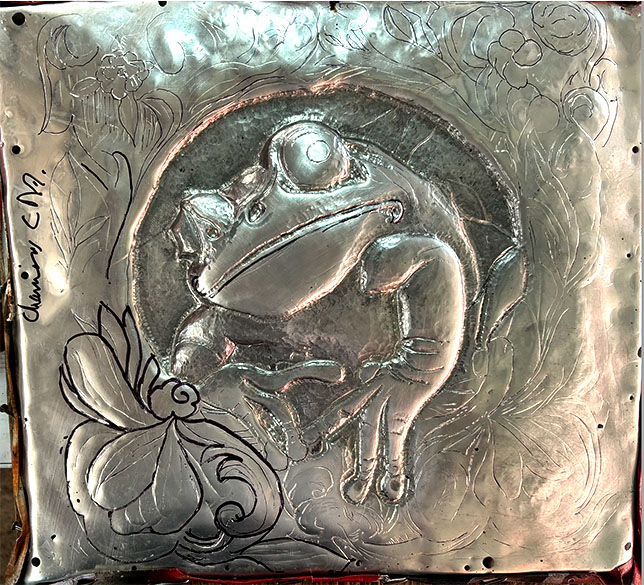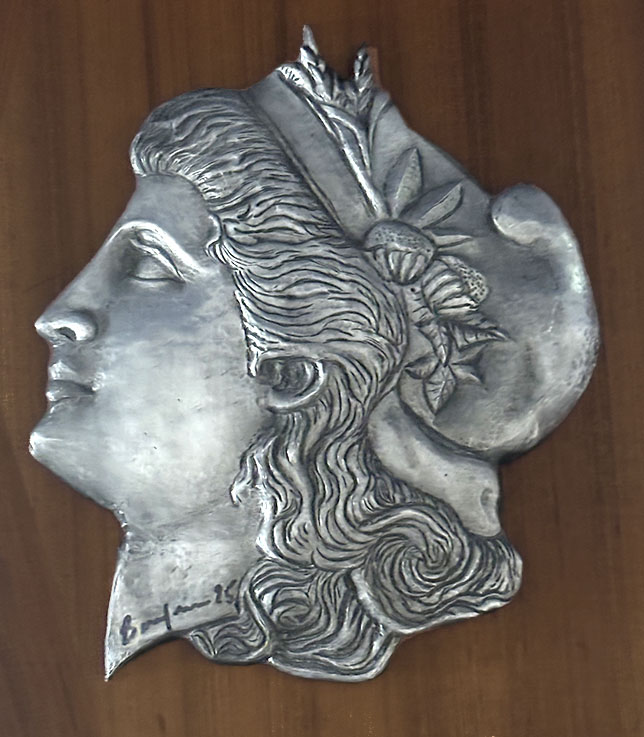What is Repoussé and Chase?
Repoussé (or repoussage) is a metalworking technique in which a malleable metal is shaped by hammering from the reverse side to create a design in low relief. Chasing (French: ciselure) or embossing is a similar technique in which the piece is hammered on the front side, sinking the metal. The two techniques are often used in conjunction.
The techniques are very ancient and have been extensively used all over the world, as they require only the simplest tools and materials, and yet allow great diversity of expression. They are also relatively economical, since there is no loss or waste of metal, which mostly retains its original size and thickness. Toolmarks are often intentionally left visible in the result.
A few among many famous examples of repoussé and chasing are the prehistoric Gundestrup cauldron, the mask on the mummy of Tutankhamun, the body armours of the Bronze Age, the copper ornaments made by the Native Americans in the Southeastern United States, and the Statue of Liberty in New York City.
The techniques of repoussé and chasing date from Antiquity and have been used widely with gold and silver for fine detailed work and with copper, tin, and bronze for larger sculptures.
During the 3rd millennium BC, in the Middle East, a variety of semi-mass production methods were introduced to avoid repetitive free-hand work. With the simplest technique, sheet gold could be pressed into designs carved in intaglio in stone, bone, metal or even materials such as jet. The gold could be worked into the designs with wood tools or, more commonly, by hammering a wax or lead "force" over it.
The alternative to pressing gold sheet into a die is to work it over a design in cameo relief. Here the detail would be greater on the back of the final design, so some final chasing from the front was often carried out to sharpen the detail.
The use of patterned punches dates back to the first half of the 2nd millennium BC, if not far earlier. The simplest patterned punches were produced by loops or scrolls of wire.
A fine example of Egyptian repoussé is the mummy mask of Tutankhamun, a Pharaoh of the late Eighteenth Dynasty. The majority of the mask was formed using the technique of repoussé from what appears to be a single sheet of gold. The lapis lazuli and other stones were inlaid in chased areas after the height of the form was completed.
Repoussé and chasing are commonly used in India to create objects such as water vessels. These vessels are generally made using sheets of copper or silver.
Repoussage and chasing were used by many Pre-Columbian civilizations in the Americas, such as the Chavín culture of Peru (about 900 to 200 BC), to make ornaments of gold and other metals.
During the Hopewell and Mississippian periods of the American Southeast and Midwest goods of repoussé copper were fashioned as ritual regalia and eventually used in prestige burials. Examples have been found with many S.E.C.C. designs such as Bi-lobed arrow motif headdresses and falcon dancer plaques. Although examples have been found in a widely scattered area (Spiro, Oklahoma, Etowah, Georgia, and Moundville, Alabama), most are in what is known as the Braden Style, thought to have originated at the Cahokia Site in Collinsville, Illinois. Several copper workshops discovered during excavations of Mound 34 at Cahokia are the only known Mississippian culture copper workshops.
The largest known sculpture created with this technique is the Statue of Liberty, properly Liberté éclairant le monde, ("Liberty Enlightening The World"), in Upper New York Bay. The statue was formed by copper repoussé in sections using wooden structures to shape each piece during the hammering process.
 |
| Basic: the assignment was to reproduce flowers (Thai way) (2023) |
 |
| Door Sign (2024) |
 |
| Primary work after Repoussée (Image from Stock photo) |
 |
| Work in progress |
 |
| Work in progress |
 |
| All Chase is done |
 |
| "Not the year of the frog" 2025 final |
 |
| Assignment: to reproduce in 3D a familiar image, 2024 |
 |
| Face exercise, 2025 |
 |
| Deep chase | | | |
 |
| Lady Liberty, 2025 |














Comments
Post a Comment